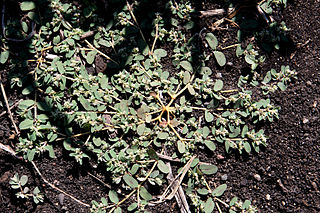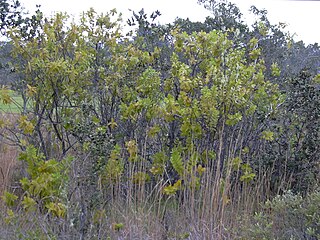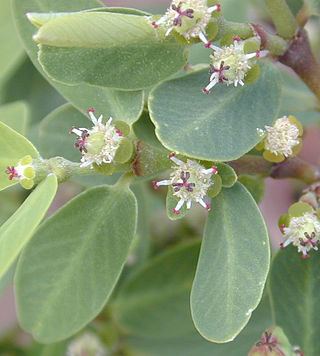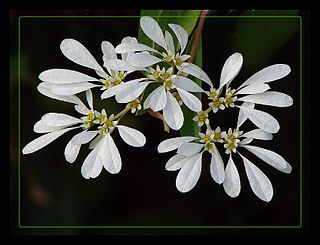
Euphorbia is a very large and diverse genus of flowering plants, commonly called spurge, in the family Euphorbiaceae. "Euphorbia" is sometimes used in ordinary English to collectively refer to all members of Euphorbiaceae, not just to members of the genus.

The poinsettia is a commercially important flowering plant species of the diverse spurge family Euphorbiaceae. Indigenous to Mexico and Central America, the poinsettia was first described by Europeans in 1834. It is particularly well known for its red and green foliage and is widely used in Christmas floral displays. It derives its common English name from Joel Roberts Poinsett, the first United States minister to Mexico, who is credited with introducing the plant to the US in the 1820s. Poinsettias are shrubs or small trees, with heights of 0.6 to 4 m. Though often stated to be highly toxic, the poinsettia is not dangerous to pets or children. Exposure to the plant, even consumption, most often results in no effect, though it can cause nausea, vomiting, or diarrhea.

Euphorbia resinifera, the resin spurge, is a species of spurge native to Morocco, where it occurs on the slopes of the Atlas Mountains. The dried latex of the plant was used in ancient medicine. It contains resiniferatoxin, an extremely potent capsaicin analog tested as an analgesic since 1997.

The Koko Crater Botanical Garden is a botanical garden located within the Koko Crater on the eastern end of Oahu, Hawaii. It was given the dual title of the Charles M. Wills Cactus Garden by the Honolulu Department of Parks and Recreation, in recognition of his contributions to the garden, in 1966.

Euphorbia maculata, known as spotted spurge, prostrate spurge, milk purslane, or spotted sandmat, is a fast-growing annual plant in the family Euphorbiaceae. While it is native to North America, where it is a common garden and lawn weed in the United States, it has become a common introduced species throughout the world, including Europe, Japan, Korea, Australia, and New Zealand.

Canavalia molokaiensis, commonly known as the Molokaʻi Jack-bean or puakauhi, is a rare species flowering plant in the legume family, Fabaceae, that is endemic to the island of Molokaʻi in Hawaii. This and other Hawaiian Canavalia are known there as ʻāwikiwiki.
Genophantis leahi was a species of moth in the family Pyralidae described by Otto Herman Swezey in 1910. It was endemic to the Hawaiian islands of Maui, Oahu, Molokai and Hawaii.
Genophantis is a genus of moths belonging to the family Pyralidae. All species are endemic to Hawaii.

Euphorbia haeleeleana, the Kauaʻi spurge, is a species of flowering plant in the croton family, Euphorbiaceae, that is endemic to the islands of Kauaʻi and Oaʻhu in Hawaii. Like other Hawaiian spurges it is known as `akoko.

Urera kaalae, opuhe, is a species of flowering plant in the nettle family, Urticaceae, that is endemic to the island of Oʻahu in Hawaii. It inhabits slopes and gulches in mesic forests at elevations of 300–760 m (980–2,490 ft). Currently it is restricted to the southern and central parts of the Waiʻanae Mountains. Associated plants include maile, hame, Asplenium kaulfusii, Athyrium spp., ʻāwikiwiki, pāpala, ʻakoko, poʻolā, ēlama, Doryopteris spp., ʻieʻi.e., manono, Hibiscus spp., olopua, māmaki, hala pepe, ʻālaʻa, kōpiko, heuhiuhi, aʻiaʻi, ōpuhe, and maua. It is threatened by habitat loss.

Euphorbia poissonii, also known as Euphorbia poissoni and, incorrectly, as Euphorbia poisoni, is a highly irritant and toxic succulent member of the large and varied spurge family of plants. It is native to northern Nigeria, where local farmers extract its latex for use as a pesticide. Its powerfully irritant and pain-producing nature mandates use as a fencing plant. It is known to the Berom people of the Jos area as pyùlúp who transplant it to their compounds where it is regarded as protection against witchcraft.

Euphorbiaceae, the spurge family, is a large family of flowering plants. In English, they are also commonly called euphorbias, which is also the name of the type genus of the family. Most spurges, such as Euphorbia paralias, are herbs, but some, especially in the tropics, are shrubs or trees, such as Hevea brasiliensis. Some, such as Euphorbia canariensis, are succulent and resemble cacti because of convergent evolution. This family has a cosmopolitan global distribution. The greatest diversity of species is in the tropics; however, the Euphorbiaceae also have many species in nontropical areas of all continents except Antarctica.

The Hawaiian tropical dry forests are a tropical dry broadleaf forest ecoregion in the Hawaiian Islands. They cover an area of 6,600 km2 (2,500 sq mi) on the leeward side of the main islands and the summits of Niʻihau and Kahoʻolawe. These forests are either seasonal or sclerophyllous. Annual rainfall is less than 127 cm (50 in) and may be as low as 25 cm (9.8 in); the rainy season lasts from November to March. Dominant tree species include koa, koaiʻa, ʻakoko, ʻōhiʻa lehua, lonomea, māmane, loulu, lama, olopua, wiliwili, and ʻiliahi. Endemic plant species in the dry forests include hau heleʻula, uhiuhi, and Gouania spp. The palila, a Hawaiian honeycreeper, is restricted to this type of habitat.
The Pearl Harbor National Wildlife Refuge is a National Wildlife Refuge on the island of Oʻahu, Hawaii. It was created in 1972 to mitigate the wildlife resource disturbances caused by construction of the Honolulu International Airport Reef Runway. The Refuge includes three units, the Honouliuli, Waiwa and Kalaeloa. The Honouliuli and Waiawa Units are managed under a cooperative agreement with the United States Navy. The Kalaeloa Unit was established during Base Realignment and Closure proceedings in 2001. Through these cooperative efforts with the Federal Aviation Administration, the State of Hawaii, and the U.S. Navy, the U.S. Fish and Wildlife Service made Pearl Harbor NWR a reality.

Euphorbia celastroides is a flowering plant in the family Euphorbiaceae. It is referred to by the common name 'akoko by Hawaiians, and is a species of spurge closely related to the poinsettia. This species develops into a round-shape shrub. This species is endemic to the Hawaiian Islands.
Euphorbia deppeana is a rare species of flowering plant in the family Euphorbiaceae known by the common names Deppe's broomspurge and Oahu sandmat. It is endemic to Oʻahu, Hawaii, where it is known from only one population in moist shrublands on Nuʻuanu Pali. Like other native Hawaiian euphorbs it is called ʻakoko locally.

Euphorbia kuwaleana is a rare species of flowering plant in the euphorb family known by the common name kokomalei. It is endemic to Oahu, Hawaii, where it is known only from a four-kilometer stretch of the Waianae Range. Like other Hawaiian euphorbs, this plant is known locally as `akoko. It is a federally listed endangered species of the United States.

Euphorbia skottsbergii is a rare species of flowering plant in the euphorb family known by the common names coastal sandmat and Skottsberg's broomspurge. It is endemic to Hawaii, where it is found in coastal shrublands on Oʻahu, Molokaʻi, Maui, and Kahoʻolawe. Like other Hawaiian euphorbs, this plant is known locally as ʻakoko.

Euphorbia cotinifolia is a broadleaf red shrub native to Mexico and South America. Treated as a shrub, it reaches 10 to 15 ft but can be grown as a tree reaching 30 ft (9.1 m). Small white flowers with creamy bracts bloom at the ends of the branches in summer. The purplish stems, when broken, exude a sap that is a skin irritant.

Euphorbia leucocephala, with many common names including little Christmas flower, white lace euphorbia, snow bush, snow flake, snows of Kilimanjaro and white Christmas bush is a species of plant in the family Euphorbiaceae. It is endemic to Mexico and Mesoamerica, and a relative of the poinsettia. Its clear sap is an irritant that can cause blisters and skin rashes. Ingesting it can cause vomiting and diarrhea.















